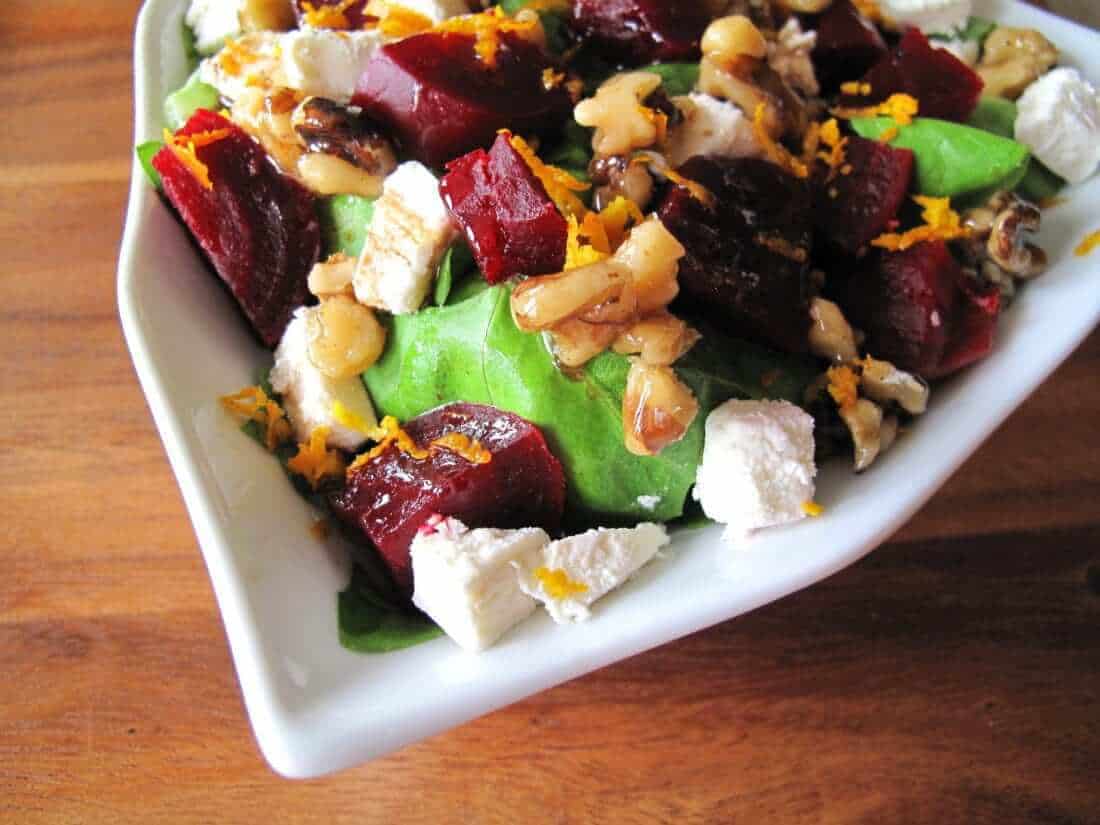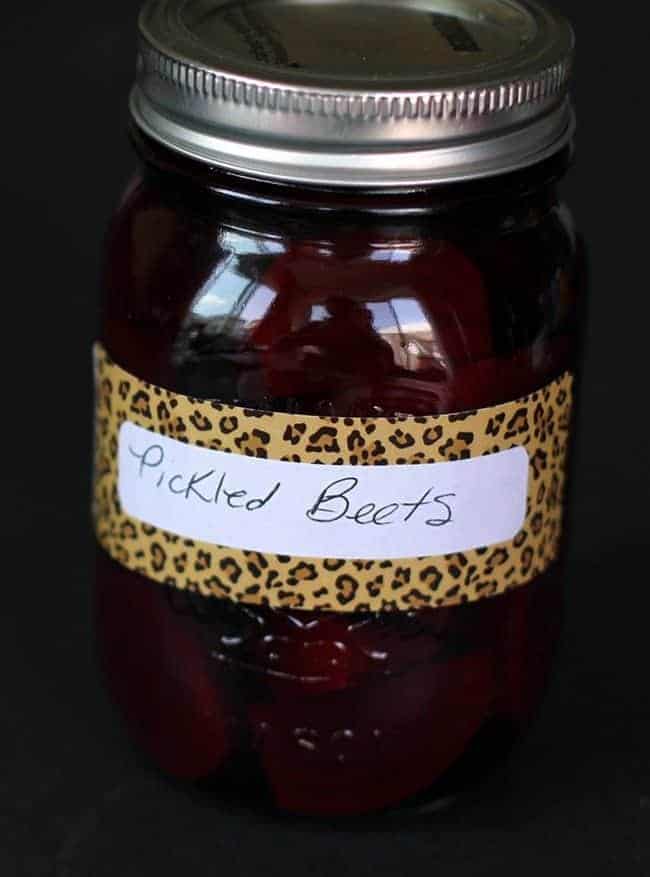This Canned Pickled Beets Recipe makes pickling beets easier than you think! It’s a tried-and-true recipe that was one of my Grandma’s favorites and is now my go-to pickled beets recipe. There is nothing like a stash of delicious beets to eat in the depths of a cold winter!

How To Make Pickled Beets
Ah, pickled beets. These purple beauties are most certainly a taste of my childhood, as my Grandma canned beets in great numbers. Unlike most children, I have loved beets since I was young, running around my Grandma’s Manitoba farm in the hot summer sun.
I could have eaten them from the jar happily all day long. Still, these were a genuinely coveted treat, usually reserved for big family dinners along with a wild duck or a beautiful venison roast. Now that I’ve taken on the canning and preserving role that my Grandmother did for so many years, I understand why they weren’t simply a snack for hungry children’s bellies, and I was shooed out to the garden to find something else.

Canning is hot, sweaty, nasty at moments, and darn hard work.
Oh yes, Pinterest and many other websites make it look glamorous and easy to boot! Suzy Homesteader is in her little white chef’s kitchen, canning away merrily all day long, with children sitting nicely at the table and the house so perfectly clean around you.
They lie.
Every single, stinking one of them.
Canning is messy.
Canning takes an organized mind, which I sadly lack some days, and canning takes a lot of reading, research, and smarts. Is it worth it? Absolutely! I sincerely wouldn’t want anyone walking away from my site thinking they are a failure because they aren’t smiling and happy like many writers portray it.
- You’re gonna sweat.
- You’re gonna swear.
- You’re going to be proud of yourself.
Sure, your kitchen will be a disaster, but canning in-season, fresh food with no preservatives and no chemicals leaching out from tin cans- knowing precisely what is in your food is worth it!

Are Pickled Red Beets Good For You?
Pickled red beets are insanely good for you! They are chock full of fiber, folate, and iron, to name a few. They are also full of tryptophan, which helps you relax and sleep better. Pickled beets are also anti-inflammatory and loaded with antioxidants. That blood-red color means that they are loaded with goodness for you.
The recipe I used is from the Atco website and can be found in my printable recipe below. I want to stress that beets are a non-acidic food, meaning, in layman’s terms, they are more dangerous to can with. Non-acidic foods that are canned can be a breeding ground for botulism, as well as many other things if you don’t follow the directions carefully. The risk is very minimal, however let’s remember that we are feeding our families with this food.
There are a few strict rules that I always follow for the safe canning of pickled beets and non-acidic foods.
1) Never change the vinegar-to-water ratio in a recipe for canning non-acidic foods. These recipes have been developed in labs to ensure the correct amount of acidity required to eliminate the chance of botulism. Botulism grows in an air-free, low-acidic environment. See how canning gives it the perfect breeding ground? When we can consume vegetables, we seal low-acid food in an oxygen-free environment. I myself do not ever change a recipe. The only thing you may alter is spices. That’s it. Nothing else.
2) Always process the food for the exact times given. Do not boil your vinegar mixture more than the recipe states. Do not skip the processing time. Find out your altitude and process accordingly.
3) Read The National Center For Home Food Preservation website. It has all the facts. Start with the FAQ, then delve into the recipes.
4) To follow up on number three, always get your recipes from reputable sites. To be honest, I’ve seen some canning recipes that just scare me. The vinegar ratios are way off, and they promote unsafe and unrecommended methods of canning. Remember, anyone can write a recipe, but you have no idea if it’s safe!
So now that I’ve scared you off canning forever, here’s the recipe!
Indeed, it’s a tried and true tested recipe from the Blue Flame Kitchen, so don’t worry! Like I said, before you make canning recipes with vegetables, just to be safe, ask where the recipe is from. Or better yet, just head to the Atco website or check out all the fantastic recipes on the National Center For Home Food Preservation
So what has everyone else been canning? I have so many recipes to share with you these next few weeks; I’ve been a busy canning bee!
Thanks for stopping in!
Happy Canning!
Love,
Karlynn

Canned Pickled Beets Recipe
Ingredients
- 4-5 pounds small beets 40 – 48
- 2 teaspoons pickling salt
- 1 1/2 cups white sugar
- 3 cups white vinegar
- 2 tablespoons mixed pickling spice tied in cheesecloth bag
- 1 cup water
Instructions
- Wash the beets and remove most of the tops, leaving about 1/2 inch of beet top remaining.In a large boiling pot of water, cook the beets until barely tender.Remove from the stove.
- Submerge the beets in a large bowl of ice water, I find this helps the skins come off with more ease.
- Cut off the tops and the roots completely, then remove the skin.Peel and slice beets into preferred size, I like larger chunks and not slices.
- Combine the vinegar, sugar, water, salt and pickling spice in a nonreactive pot and bring mixture to a boil; reduce the heat and simmer 10 minutes.
- Add the beets to the pickling liquid and return to a boil.Remove the spice bag.Carefully ladle the beets and pickling liquid into hot sterilized pint jars, leaving 1/2 inch headspace.
- Remove any air bubbles with a non-metal utensil.Add additional pickling liquid, if needed, to keep the proper headspace.
- Wipe the jar rims thoroughly with a clean damp cloth, failure to do this can result in the jars not sealing properly!
- Seal the jars and process for 35 minutes in a boiling water bath.
- For altitudes higher than 3000 ft (914 m), add 5 minutes to processing time.
Nutrition









Becky Shepherd says
You can’t change the ratio of vinegar to water safely. The sugar is there mostly as a flavouring (I think) so you could use less, but don’t reduce the amount of vinegar unless you’re making a small batch and reducing the amount of water in the same ratio.
Becky Shepherd says
Anything can be intimidating when your first start.
I’ve gotten a fair number of my friends started canning, and baking. I’ve found that most people learn better and become confident quicker if they learn in person from a friend or family member. Since I learned all sorts of cooking and preserving from my mom and grandmothers this makes sense to me. So I pass it on by sharing with my friends.
Becky Shepherd says
They look ok for fridge pickles to me. Her advice to water bath can them for only 5 minutes is definitely off, and no mention of adjusting for altitude either.
All the recipes I checked earlier this year for canning pickles suggested boiling for 20m.
Becky Shepherd says
Non-stick cookware counts too.
Becky Shepherd says
Do your pickled green tomatoes still have a crunch to them when you open the jars?
I ended up tossing about 10lbs of green tomatoes at the end of this season (after making a big batch of salsa with the rest of my green tomatoes) because I thought it would be awful if I went to all the effort of canning, and then we hated them because they were mushy.
If they did stay crunchy would you mind sharing your method/recipe?
Becky Shepherd says
The seeming conflict is because with regular beets you’re not adding vinegar.
Vinegar itself kills bacteria and creates a hostile enough environment that they can’t grow.
So if you’re just canning beets you need to pressure can them, but for pickling a water bath is sufficient because of the vinegar. At least, that’s my understanding.
Becky Shepherd says
Is it just a taste issue? I love the taste of vinegar and I’ve been trying to figure out if upping the acidity (aka either adding more vinegar than water, or using pickling vinegar instead of ‘regular’) is as dangerous as increasing the amount of water.
LarryWard says
I have raised golden beets for the past couple years. They taste better to me and there is no bleeding. I have found that if you wash the beets, wrap them each in aluminum foil, drizzle them with olive oil and cook them in a crockpot overnight in the morning the tops and roots are cut off and the skin will peel right off. Then you can eat them or can them easier.
Also in my basement is an old stone potato bin that I store my beets in. The bin is filled with sawdust and the beets are buried in it ( not touching each other). I have had beets that have been in the bin for 2 years and had no loss of firmness or flavor. They were put in with 1 inch of top and the root intact and covered completely. Took some out this morning that were grown last year and they are still perfect. I will be pressure canning them tomorrow.
we have done the same with Detroit Reds and Cylindras with the same results.
VinegarDilemma says
So many recipes call for “white vinegar” – does this refer to 5% acidity vinegar or the pickling vinegar (7% acidity) – they’re both white! Which one is used in the recipe you provided from Atco? I really wish recipes were clearer. A 2% difference in acidity does make a difference (or else it wouldn’t be recommended for pickling). Also, many canning books I read, although they say to “seal” the jars, don’t say if the beets should be in a hot water bath as your recipe mentions. I always did my beets in a hot water bath, but now would like some clarification. (I tried the pressure cooker/canner method, followed it to a T, and YUK … very disappointing end results – beets were waaayyy overcooked and pigmentation nearly gone. I should add, however, that it’s been nearly a week since that poor batch – pressure canner – and the pigmentation did return somewhat. I will likely use in either BBQ sauce recipes or other vinegar-type recipes – just so I don’t have to throw it away.)
VinegarDilemma says
I should also add: The reason I tried canning a batch of beets in a pressure canner last weekend is because I was reading over the several books I have on preserving foods, etc. They all say that the only safe method to preserve/can low acidic foods (e.g., beets) is to use a pressure canner. Yet, the Atco recipe you provide says to use hot water bath. The more I read to try to “perfect” my method and ensure my food is safe for consumption (without the fear of botulism or other micro-organisms spoiling my hard work), the more confused I get. I’m reminded of the days my mother preserved the garden foods for the long winter months. I can assure you that with 11 hungry children, there were luxuries in the home (but there was love ;o) – she certainly never owned a pressure canner. Maybe it was Providence, but we never died from her method of canning beets (everything was kept hot and into the jars and sealed – not even put in a hot water bath!). My sister has been using her beet recipe for decades (same as her mother-in-law’s recipe), and to date, no one has ever gotten botulism or died from their methods of canning beets. Now I’m wondering if beets really need to be in a hot water bath at all if everything is hot once the cap is on the jars, and they all seal properly. Your comments are appreciated ;o)
TedKompu says
@VinegarDilemma Pressure canning is the only safe alternative unless you use the appropriate amount of vinegar with the water bath method. The main reason is that only pressure canning generates sufficient heat to eliminate risks of botulism. The water bath method is equally safe as long as you use the right amount of vinegar which controls the development of botulism. I highly recommend you to consult the following links for detailed instructions on how you can use your pressure canner to process beets (https://nchfp.uga.edu/how/can_04/beets.html) or the water bath method to pickle your beets safely (https://nchfp.uga.edu/how/can_06/pickled_beets.html).
I hope this helps!
thekitchenmagpie says
They are two different things, so I mean white vinegar, not pickling. Pickling vinegar can be SO harsh at 7% that it’s not that commonly used, normal 5% white vinegar is the standard.
https://nchfp.uga.edu/how/can_06/prep_foods.html
Jb says
Regular or pickling vinegar?
thekitchenmagpie says
@Jb Always regular unless specified as pickling, as pickling can be too acidic flavour-wise for some canning.
AdlaiArmundsen says
BS. Canning is no harder than anything else. You plan, then you lay out your tools and other supplies. Wash the produce, make jars and bands sterile, simmer the lids but don’t boil. 180 degrees is fine. Do small batches and don’t rush and be CLEAN! I’m a guy and don’t find it hard at all. I did 30 quarts of pickled green tomatoes, 5 pints of hot sauce and 12 pints of applesauce and I didn’t sweat a drop. This year I plan to do pickled onions, beets and lima beans.
freddiemercury says
_u*********@li******.com" profile_url="https://www.livefyre.com/profile/81004482/" ns="true">AdlaiArmundsen If you are A GUY, what the hell are you doing canning green tomatoes?
thekitchenmagpie says
_u*********@li******.com" profile_url="https://www.livefyre.com/profile/81004482/" ns="true">AdlaiArmundsen I’m super glad that you don’t find it hard however I run a website encouraging beginners by being HONEST about everything. And canning I find hard. Baking, no, canning yes.
surferman67 says
I used your receipt for pickling beets had a heck of a time trying to get the skins off did like you said just didn’t want to come off
Zeddy says
_u*********@li******.com" profile_url="https://www.livefyre.com/profile/67016331/" ns="true">surferman67 my baba was always a fan of don’t boil the beets at all and just cut / peel the skin off like anything else. She wasn’t wanting to play!
descott204 says
Hi… im working on preserving beets and i am wondering if it would be a big deal to cut and peel the beets prior to cooking them. is it that they lose too much flavour? thanks for your great tips..Dianne
sharon says
I am at present in the midst of pickling 30 pounds of garden fresh beets with garden fresh added garlic.
Laura T says
i’ve been floundering alone in my kitchen for the last couple of years learning how to can, yet i come from a long line of very talented women canners so for as much as alot comes naturally, i actually knew nothing and am learning off the internet….., your introduction i just read had me laughing and has renewed my hope in continuing to learn how to can our foods, and hopefully teach my daughter…..thanks!
Khouse says
Just finished pickling most of a bushel of beets. LOVE it. Peeling them is the worst job but I love canning much I am still happy. Also canned tomatoes, red peppers, jalapeno peppers, corn reli
DalboDude says
_u*********@li******.com" profile_url="https://www.livefyre.com/profile/22606762/" ns="true">Khouse After the beets are cooked use a metal or plastic pot scrubber and just scrub the skins off, easy.
JoAnnGillis says
Is it safe to pickle beets with the having the same amount of vinegar and sugar.
Thanks.
sharon says
_u*********@li******.com" profile_url="https://www.livefyre.com/profile/22228152/" ns="true">JoAnnGillis Yes, you can use equal sugar and vinegar. I have canned pickled beets using only this , one spice for forty years. 🙂
jo p says
I don’t know how my mother did it. She worked full time as a single mother, raised a huge garden, did all the housework, laundry, etc., and canned all the food. Just the small amount of canning I have done this year has about done me in, but, as you said, it’s worth it.
thekitchenmagpie says
@jo p I know. We forget the fortitude of the generation that HAD to can as a way of life and making sure you had food all winter! Worth it but man, when I think of what my Grandma put up every year? Crazy!
jo p says
My mother made pickled beets when I was growing up that I loved. She didn’t use any spices. I absolutely hate cloves, so she left them out. Glad to see your recipe as my mother’s recipe is very minimal, so I will follow yours leaving out the spices. My mother’s recipe was: Cut tops off beets. Boil beets about 1/h hour or until tender. Skin. 1 cup vinegat to 1 cup sugar. Bring to boil and drop in beets. Bring to boil and can. I have a pickle relish recipe that was my great grandmother’s that called for 5 cents celery seed, 5 cents mustard seed, and 2 1/2 cents tumeric. So funny.
thekitchenmagpie says
@jo p Oh my goodness, what a recipe! I love pickle relish!
Emily Ouellette says
yumm! i remember my grandma used to dill different stuff and I always wanted to try it for myself. Now I can 🙂
Karlynn Johnston says
Non-reactive cookware = clay, enamel, glass, plastic, or stainless steel.
I’m surprised Jim eats canned goods at all lol!
Genevieve Olivier says
I actually want to make some pickled Golden Beets.
The Kitchen Magpie says
Yes, shades of a Canadian childhood I tell you! A lot of this generation of kids is missing out, sadly. I’m always reminded of my grandma when I eat these…
Donna McGougan says
One of my childhood favs too!!
Genevieve Olivier says
My mom makes a mean pickled beet. Gonna make some in the fall.
The Kitchen Magpie says
Oh and plus, fridge pickles are exposed to oxygen, making the whole no-air seal not a big thing, so a lower ratio is ok for those. But I like higher ratio for TASTE! I can’t wait to share the recipe, they are SO GOOD!
Genevieve Olivier says
We used the Bernardin pickle anything recipe in their book. Used cukes and zucchini. I found the brine a bit sweet. But won’t know how they are for a couple weeks. Tonight we are doing dill pickles with more tang.
The Kitchen Magpie says
I just made fridge pickles with carrots (recipe soon) and my vinegar ratio is far higher than that…I always just count on Atco or that home preserving site….BUT I haven’t made dill pickles yet!
The Kitchen Magpie says
I get really scared sometimes when I read some of those recipes out there. Fruits are fine to alter sugar and stuff because of their high acidity but vegetables? I never mess with them. Lab proven recipes only for my family!
Genevieve Olivier says
So true about different recipes that sorta skip steps or have odd ratios. We are too scared to mess with recipes while still learning.